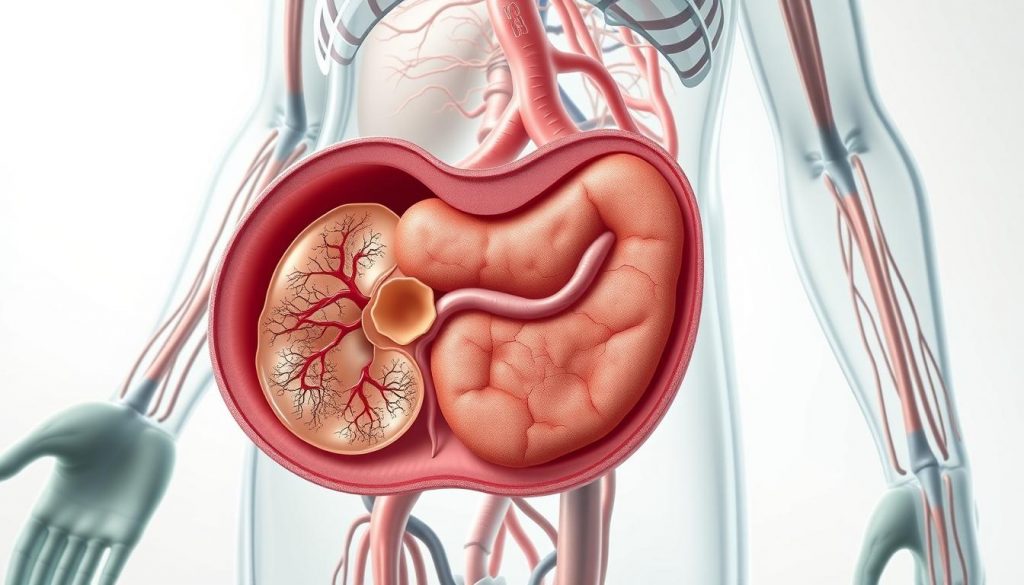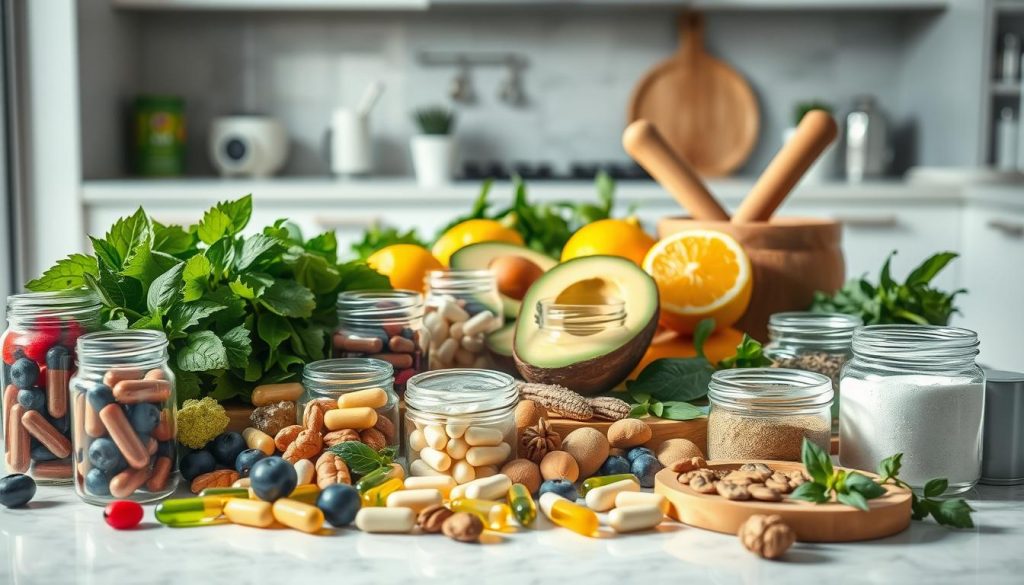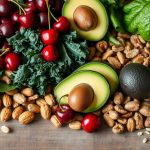Have you ever wondered how to effectively reduce body fat while maintaining energy levels and overall health? The answer lies in a combination of strategic diet, consistent exercise, and scientifically-backed methods. Our approach focuses on blocking fat absorption and boosting your body’s natural weight management processes, all while ensuring you feel energized and motivated throughout your journey.
Research from the University of Florida and other reputable sources highlights the importance of timing and calorie control in any fat-blocking strategy1. By integrating resistance training, for example, you can decrease body fat by an average of 1.46% over just four weeks2. Additionally, incorporating interval training and strength exercises can further enhance fat loss efforts, making your workouts more efficient and effective.
Our method is designed to be sustainable and health-focused, emphasizing whole foods, adequate protein intake, and proper hydration. Studies show that diets rich in whole grains and lean proteins, combined with regular aerobic exercise, can lead to significant weight loss and improved body composition12.
Table of Contents
Key Takeaways
- A combination of diet, exercise, and timing is key to effective fat blocking.
- Resistance training can reduce body fat by 1.46% in just four weeks.
- Whole foods, lean proteins, and proper hydration support sustainable weight loss.
- Interval training and strength exercises enhance fat loss efforts.
- Scientific research backs our comprehensive approach to weight management.
Introduction to Fat Blocking and Weight Loss
Understanding how to block fat absorption is a cornerstone of effective weight management. Our approach combines diet, exercise, and scientifically-backed strategies to help you achieve your goals while maintaining overall health.
Our Approach to Integrating Diet and Exercise
A balanced diet is crucial for blocking fat absorption. By focusing on whole foods and lean proteins, you can reduce calorie intake while keeping your body nourished. Regular exercise, especially resistance training, complements dietary efforts by burning fat and maintaining muscle mass3.
Why Understanding Fat Blocking Matters
Fat blocking is more than just a weight loss strategy; it’s about understanding how your body processes food. Supplements can play a role, but their effectiveness varies. For instance, chitosan may help block dietary fat, though results are modest4. Combining supplements with a healthy diet and exercise yields better results.
| Strategy | Effectiveness | Recommendation |
|---|---|---|
| Dietary Changes | High | Focus on whole foods and lean proteins |
| Supplements | Modest | Use chitosan or CLA for additional support |
| Exercise | High | Incorporate resistance and aerobic training |
By integrating these strategies, you can create a sustainable plan that supports your weight loss journey and overall well-being.
Understanding the Science Behind Fat Blocking
Exploring the biological processes that govern fat absorption and weight management can provide deeper insights into effective strategies. Recent studies have shed light on how certain enzymes and hormones influence our ability to lose weight and maintain a healthy body composition.
Exploring Leptin Resistance and PTP1B Inhibition
Leptin, a hormone produced by fat cells, plays a crucial role in regulating energy balance and appetite. However, leptin resistance, where the body fails to respond effectively to leptin, is a common issue in obesity. Research shows that nearly all obese individuals develop leptin resistance, making weight loss more challenging5.
PTP1B, an enzyme that inhibits leptin signaling, has emerged as a key target in addressing leptin resistance. Studies indicate that inhibiting PTP1B can enhance leptin signaling, potentially improving the body’s ability to burn fat and suppress appetite5.
Key Findings from Recent Research
Scientists at the University of Florida have explored the use of vanadium to inhibit PTP1B, showing promise in restoring leptin function and promoting weight loss. Their findings suggest that combining vanadium with leptin therapy can lead to greater reductions in body fat compared to leptin alone5.
Additionally, research published in the journal Endocrinology highlights the importance of understanding individual differences in hormonal responses. These differences can significantly impact the effectiveness of weight loss strategies and the likelihood of obesity5.
| Mechanism | Effect | Recommendation |
|---|---|---|
| Leptin Signaling | Regulates energy balance and appetite | Address leptin resistance through dietary and lifestyle changes |
| PTP1B Inhibition | Enhances leptin function and fat burning | Consider supplements or therapies targeting PTP1B |
| Combined Approach | Improves weight loss outcomes | Integrate both dietary and therapeutic strategies |

Understanding these biological mechanisms is essential for developing effective weight loss strategies. By targeting leptin resistance and PTP1B inhibition, individuals can better manage their weight and improve overall health. For more information on how supplements can aid in weight loss, visit our guide on carb blockers and their impact on keto.
Effective Fat Blocking Strategies: Diet and Supplements
Discovering how to effectively block fat absorption while maintaining a healthy lifestyle is a key aspect of weight management. The combination of a well-balanced diet and carefully chosen supplements can significantly enhance your efforts to reduce body fat and support overall well-being.
Natural Ingredients and Their Roles
Natural ingredients play a vital role in fat blocking. Green tea extract, for instance, is known to enhance fat burning due to its catechins, which may require multiple servings daily for optimal effect6. Soluble fiber, found in foods like oats and barley, helps slow down digestion, reducing calorie absorption and promoting a feeling of fullness.
Carnitine, an amino acid, supports the transport of fatty acids into the mitochondria, where they are burned for energy. This not only aids in fat loss but also improves energy levels during workouts.
How Food Choices and Supplements Work Together
A combination of strategic food choices and supplements can create a powerful synergy. For example, incorporating lean proteins like chicken breast or fish into your meals helps maintain muscle mass while keeping calorie intake in check. Pairing this with supplements like chitosan can further reduce fat absorption, making your weight loss efforts more effective.
Whole foods rich in water, such as cucumbers and oranges, not only provide essential nutrients but also help control appetite by filling up the stomach, reducing overall calorie intake6.
| Ingredient | Role | Benefit |
|---|---|---|
| Green Tea Extract | Enhances fat burning | Supports weight loss |
| Soluble Fiber | Slows digestion | Reduces calorie absorption |
| Carnitine | Transports fatty acids | Aids in fat loss and energy production |

By integrating these strategies, you can create a sustainable plan that supports your weight loss journey. For more information on how supplements can aid in weight loss, visit our guide on weight loss supplements and their impact on your body.
Integrating Exercise for Optimal Fat Blocking
Exercise plays a vital role in enhancing fat reduction efforts by boosting metabolism and increasing energy expenditure. A well-structured workout routine can significantly contribute to your weight loss journey by targeting specific areas and improving overall body composition.
Workout Techniques That Boost Metabolism
High-intensity interval training (HIIT) is a powerful tool for fat loss. Studies show that HIIT can keep your body burning fat for up to 24 hours after exercise7. This method not only enhances metabolism but also improves cardiovascular health. Additionally, incorporating strength training with heavy weights and fewer reps is more effective for calorie burning than lighter weights with more reps7.
Another effective technique is steady-state cardio, such as jogging or cycling, which burns calories during exercise. For example, a 150-pound person running at 6 mph for 30 minutes burns approximately 341 calories7. Walking at 3.5 mph for the same duration burns around 136 calories7, showing the impact of intensity on calorie burn.
Linking Energy Expenditure to Fat Reduction
Energy expenditure is crucial for fat reduction. High-intensity workouts lead to a greater total calorie burn, including both glycogen and fat calories8. After high-intensity workouts, the body experiences excess post-exercise oxygen consumption (EPOC), continuing to burn more calories post-exercise compared to low-intensity workouts8.
Low-intensity workouts require longer durations to burn the same amount of calories as high-intensity workouts8. This highlights the efficiency of incorporating both types of exercises into your routine for sustained results.
| Strategy | Effectiveness | Recommendation |
|---|---|---|
| High-Intensity Interval Training (HIIT) | High | Incorporate HIIT sessions 3-4 times a week |
| Steady-State Cardio | Moderate | Aim for at least 30 minutes per session |
| Strength Training | High | Focus on heavy weights with fewer reps |
By integrating these strategies into your daily routine, you can achieve a balanced approach to weight loss that combines diet and exercise for optimal results. Remember, consistency and patience are key to overcoming challenges like obesity and achieving your weight loss goals.
Implementing Our How-To Guide for Sustainable Fat Prevention
Creating a sustainable plan for fat prevention involves a combination of strategic planning, consistent execution, and careful monitoring. Our guide provides a roadmap to help you integrate these strategies into your daily life effectively.
Step-by-Step Planning and Execution
Starting with meal preparation is essential. Focus on whole, nutrient-dense foods like lean proteins, vegetables, and whole grains. According to research, combining a reduced-calorie diet with regular physical activity can lead to a weight loss of approximately 7.2 kg over six months9. Additionally, scheduling exercise sessions is crucial. High-intensity interval training (HIIT) and strength training are highly effective for fat loss and can be incorporated 3-4 times a week10.
Monitoring Progress and Making Adjustments
Regularly tracking your weight, body fat percentage, and blood markers is vital. For instance, studies show that maintaining a healthy body fat percentage (21-35% for women) is important for overall health10. If you notice plateaus, consider adjusting your calorie intake or exercise intensity. For example, increasing energy expenditure by 1,000 kcal/week can enhance weight loss efforts9.
| Strategy | Action | Benefit |
|---|---|---|
| Meal Preparation | Plan meals with whole foods | Supports sustainable weight loss |
| Exercise Routine | Incorporate HIIT and strength training | Boosts metabolism and fat burning |
| Progress Monitoring | Track weight and blood markers | Helps in making informed adjustments |
For more guidance on effective weight management, visit our control appetite suppressant guide to learn how supplements can support your journey.
Conclusion
Effective fat reduction and weight management require a holistic approach that combines diet, exercise, and strategically chosen supplements. Our comprehensive guide has outlined how these elements work together to help you achieve your weight loss goals while maintaining overall health.
Understanding the science behind fat absorption and metabolism is crucial for sustainable results. For instance, fat blockers like orlistat can prevent the absorption of about 25% of dietary fat11, while supplements like CLA may aid in reducing body fat over time12. These tools, when used correctly, can enhance your efforts to lose weight and improve body composition.
The journey to overcome obesity and maintain a healthy weight is not without challenges. However, by integrating practical steps like meal planning, regular exercise, and mindful supplement use, you can create a sustainable plan. Remember, consistency and patience are key to achieving long-term success.
As you continue on your path to better health, we encourage you to explore innovative methods and consult reliable sources. For more insights on how supplements can support your weight loss journey, visit our guide on fat and carb blockers.
FAQ
How does fat blocking help with weight loss?
What are the best foods to eat for effective fat blocking?
Can supplements aid in blocking fat absorption?
How long does it take to see results from fat blocking?
Is fat blocking safe for everyone?
How does exercise contribute to fat blocking?
What role does blood flow play in fat blocking?
Can fat blocking reduce appetite?
How does fat blocking impact blood sugar levels?
What are the potential side effects of fat blocking supplements?
Can fat blocking be combined with other weight loss methods?
Source Links
- 12 Sustainable Ways to Burn Body Fat – https://www.healthline.com/nutrition/best-ways-to-burn-fat
- 5 Fat-Burning Strategies – https://www.webmd.com/diet/features/5-fat-burning-strategies
- Weight loss stalled? Move past the plateau – https://www.mayoclinic.org/healthy-lifestyle/weight-loss/in-depth/weight-loss-plateau/art-20044615
- The Truth About Weight-Loss Pills – https://www.webmd.com/obesity/features/truth-about-weight-loss-pills
- Blocking enzyme helps fat-burning hormone fight obesity – UF Health – https://ufhealth.org/news/2005/blocking-enzyme-helps-fat-burning-hormone-fight-obesity
- Fat-Fighting Foods – https://www.webmd.com/diet/ss/slideshow-fat-fighting-foods
- Maximizing Fat Loss: Combining Fat Burners with Diet and Exercise – https://www.cibdol.com/blog/2038-maximizing-fat-loss-combining-fat-burners-with-diet-and-exercise
- The Truth of the Fat Burning Zone: What is the Best Heart Rate to Lose Fat? – https://www.mountelizabeth.com.sg/health-plus/article/fat-burning-zone-heart-rate-to-lose-fat
- Weight-Loss and Maintenance Strategies – Weight Management – https://www.ncbi.nlm.nih.gov/books/NBK221839/
- How to lose body fat in a healthy, sustainable way, according to experts – https://www.womenshealthmag.com/uk/food/weight-loss/a707401/how-to-lose-body-fat/
- FDA Mulling OTC Sale Of Fat Blocking Pill; Experts Eye Glaxo Weight Loss Drug – https://www.biospace.com/fda-mulling-otc-sale-of-fat-blocking-pill-experts-eye-b-glaxo-b-weight-loss-drug
- Can CLA (Conjugated Linoleic Acid) Help You Lose Weight? – https://www.healthline.com/nutrition/cla-and-weight-loss












